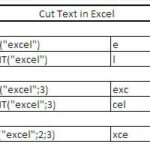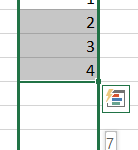Generating QR Codes in Excel: An Overview
Creating QR codes directly within Excel allows you to encode data, URLs, and information into scannable codes while keeping everything organized in your spreadsheet. Excel offers multiple methods for QR code generation, ranging from simple built-in functions to advanced automation, making it easy to generate codes for inventory tracking, product labeling, customer engagement, or data management. Unlike external tools, generating QR codes in Excel keeps your data and codes together in one centralized location.
Method 1: Using the IMAGE Function in Microsoft 365 Excel
The most straightforward method for modern Excel users is the IMAGE function, which is available in Microsoft 365 and Excel 2024 and later. This function retrieves QR code images from a web service and displays them directly in cells, creating truly dynamic codes that update when your source data changes.
To use this method, enter your data in a column for example, place a URL in cell A1. In an adjacent cell, enter the IMAGE formula that references your data. The formula works by combining a QR code generator service URL with your cell reference, so when you modify the cell content, the QR code automatically regenerates. The resulting QR codes display directly within cells, maintaining proper alignment and allowing you to resize cells to accommodate the images.
This method offers significant advantages for bulk operations. You can copy the formula down an entire column to generate QR codes for hundreds or thousands of rows simultaneously. The dynamic nature means if you update any source data, the corresponding QR codes instantly reflect those changes without requiring manual regeneration.
Method 2: Using the LAMBDA Function for Custom Formulas
For users who prefer a cleaner, more user-friendly approach, Excel’s LAMBDA function allows you to create a custom QR code generator function. This wraps the IMAGE function logic into a simplified formula that you can use throughout your spreadsheet without remembering complex syntax.
By creating a LAMBDA function once in your workbook, you establish a reusable custom function that simplifies QR code generation. You simply reference the cell containing your data and specify the desired QR code size, and the LAMBDA function handles the complex URL construction behind the scenes. This approach reduces the likelihood of accidental formula edits and makes your spreadsheet more professional and maintainable.
For example, after setting up your custom LAMBDA function, you can generate a QR code with a single, straightforward formula that only requires you to specify the input cell and desired dimensions. This method eliminates the need for VBA coding while providing powerful customization options within Excel’s native formula environment.
Method 3: Installing a QR Code Add-in
If you use an older version of Excel that doesn’t support the IMAGE or LAMBDA functions, installing a dedicated QR code add-in provides an accessible alternative. Excel offers several free and paid add-ins specifically designed for QR code generation, such as QR4Office and Kutools.
To install an add-in, go to the Home tab and click Get Add-ins. Search for “QR Code” in the Microsoft Store and select the add-in that meets your needs. Once installed, the add-in appears in your ribbon, making QR code generation accessible with just a few clicks. When you select a cell containing data and activate the add-in, it generates a QR code that you can customize by color, size, and error correction level before inserting it into your spreadsheet.
Add-ins work well when you need occasional QR codes or prefer graphical interfaces for customization. However, keep in mind that QR codes generated via add-ins are inserted as image objects rather than cell-embedded formulas, so they require manual regeneration if your source data changes. Kutools specifically excels at bulk generation, allowing you to select a range of cells and generate QR codes for all of them simultaneously.
Method 4: Using VBA Automation for Advanced Workflows
Advanced Excel users can leverage VBA (Visual Basic for Applications) to create fully automated QR code generation workflows. With VBA, you can write custom scripts that generate QR codes in bulk, automatically name them based on cell content, and place them precisely within your spreadsheet layout.
To use VBA, access the Visual Basic Editor by pressing Alt + F11 and insert a new module where you’ll paste your QR code generation code. The code creates a user-defined function that you can call from any cell in your spreadsheet, just like a built-in Excel function. This method is particularly powerful when working with large datasets where you need hundreds or thousands of QR codes generated with minimal manual intervention.
VBA approaches can handle complex scenarios such as generating QR codes for specific ranges, placing them in predetermined layouts, and even exporting them as separate image files. If your VBA knowledge is limited, you can find pre-written scripts online that you can customize to fit your specific needs.
Setting Up Your Excel Spreadsheet for QR Code Generation
Before generating QR codes, structure your Excel data appropriately to ensure efficient processing. Create clear column headers that identify what data each column contains for example, “Product ID”, “URL” or “Tracking Number”. Organize your data consistently so that all entries in a column follow the same format, as QR codes will encode data exactly as it appears in the cells.
Reserve adjacent columns for your QR codes if using the IMAGE or LAMBDA methods, ensuring sufficient column width and row height to accommodate the generated images. If using an add-in, you may want to keep source data and QR codes on the same row for easy reference.
Ensuring QR Code Accuracy and Scannability
QR code complexity increases with the amount of encoded data. Simple short URLs generate small, simple codes that scan reliably, while longer text strings create denser codes that require higher-quality printing or scanning technology. Test your QR codes with various scanners before implementing them widely use your smartphone camera or a dedicated QR scanner app to verify that each code contains the correct information.
Pay special attention to data formatting. URLs must be complete and properly formatted to work correctly when scanned. If encoding email addresses, ensure they follow standard email format with the “@” symbol. For inventory or identification numbers, verify that special characters don’t introduce errors during encoding.
Managing Data Privacy and Security
When generating QR codes that contain sensitive information such as internal tracking numbers, employee IDs, or confidential URLs be mindful of who can access your Excel file. Consider password-protecting your workbook or using Excel’s permission features to restrict access. If sharing files containing QR codes, ensure that anyone scanning the codes has appropriate authorization to access the encoded information.
For QR codes that link to online resources, verify the destination URLs are secure and current before widespread distribution. Outdated links can frustrate users or lead to broken references, damaging your organization’s credibility.
Generating QR codes within Excel streamlines your workflow by keeping data management and code generation in one centralized location. Whether you choose the dynamic IMAGE function for modern Excel, a user-friendly add-in for quick operations, or advanced VBA for complex automation, Excel provides flexible options to match your specific requirements. By properly structuring your data and testing your codes before deployment, you can create reliable, scannable QR codes that enhance tracking, engagement, and data management.



